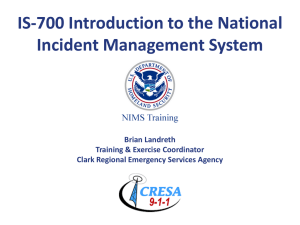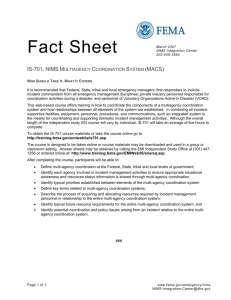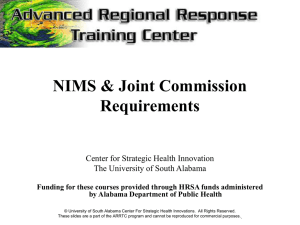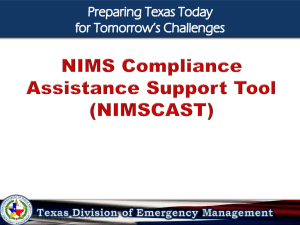National Incident Management Systems Course
advertisement
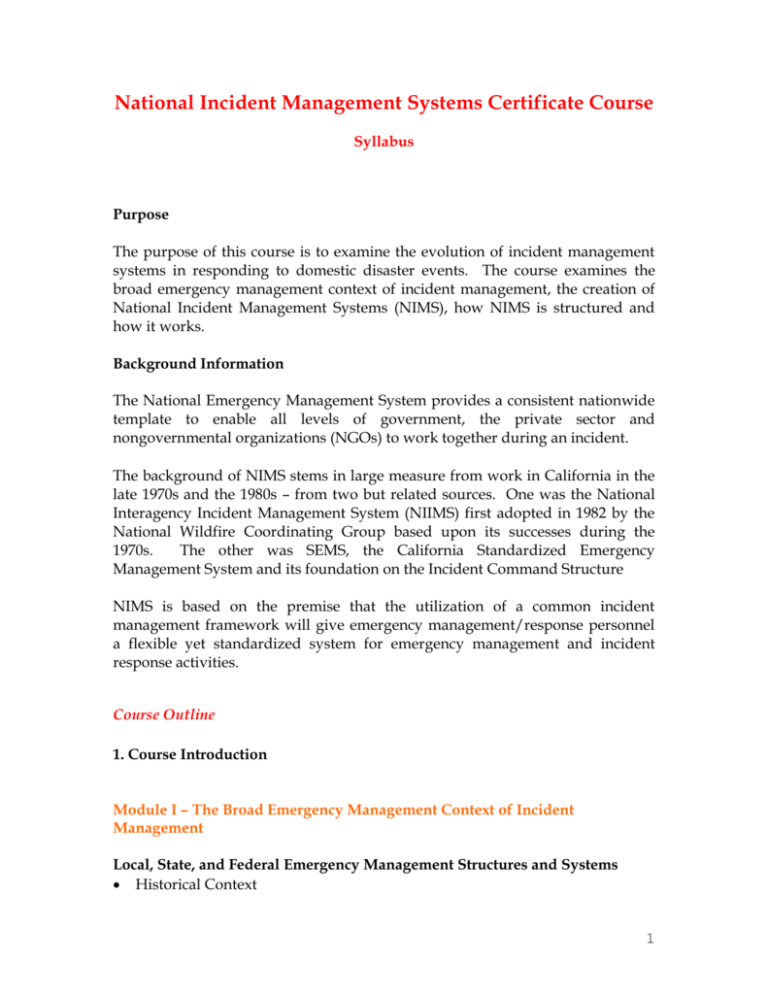
National Incident Management Systems Certificate Course Syllabus Purpose The purpose of this course is to examine the evolution of incident management systems in responding to domestic disaster events. The course examines the broad emergency management context of incident management, the creation of National Incident Management Systems (NIMS), how NIMS is structured and how it works. Background Information The National Emergency Management System provides a consistent nationwide template to enable all levels of government, the private sector and nongovernmental organizations (NGOs) to work together during an incident. The background of NIMS stems in large measure from work in California in the late 1970s and the 1980s – from two but related sources. One was the National Interagency Incident Management System (NIIMS) first adopted in 1982 by the National Wildfire Coordinating Group based upon its successes during the 1970s. The other was SEMS, the California Standardized Emergency Management System and its foundation on the Incident Command Structure NIMS is based on the premise that the utilization of a common incident management framework will give emergency management/response personnel a flexible yet standardized system for emergency management and incident response activities. Course Outline 1. Course Introduction Module I – The Broad Emergency Management Context of Incident Management Local, State, and Federal Emergency Management Structures and Systems Historical Context 1 Four Phases of Emergency Management Local Emergency Management - Agencies involved - The EOP and the EOC State Emergency Management Tribal Organizations agencies involvement Private sector, VOADs, NGOs and Service Providers National Coordination Mechanisms Why national coordination mechanisms are necessary The evolution of national coordination mechanisms - Before the Federal Response Plan (FRP) - The FRP - The National Response Plan (NRP) - The National Response Framework (NRF) A History of Incident Command and Coordination Emergency management standards Incident command systems defined and explained How incident command changed modern emergency management Incident command evolution; from ad-hoc to standardized Before the Incident Command System (ICS) Historical development of ICS in the US and throughout the world The Incident Command System (ICS) Concepts and Principles Management Characteristics Organization and Operations Perspectives on Incident Management Systems Pros and cons associated with the use of an incident command system Incident command limitations Obstacles to the effective implementation or application of incident command Alternatives to ICS (Incident command systems other than ICS) Module II – NIMS Creation Homeland Security Presidential Directive-5 and NIMS Development HSPD-5 Purpose HSPD-5 Policy HSPD-5 Taskings The NIMS development process 2 Commentary on NIMS by State and local users NIMS documentation and publications What is the National Incident Management System (NIMS)? NIMS explained NIMS Doctrine, concepts, principles, and terminology Justification for a NIMS NIMS Implementation The NIMS development and implementation timeline The “NIMS Timeline” for adopting agencies NIMS adoption rules and requirements Obstacles to NIMS implementation Module 111: NIMS Structure NIMS Structure Defined Introduction and overview Command and management Preparedness Resource management Communications and information management Supporting technologies Ongoing management and maintenance Preparedness NIMS Preparedness Concepts Achieving Preparedness Maintaining Preparedness Communications and Information Management Communications and information management explained Communications and information management concepts and principles Managing communications and information under NIMS Resource Management NIMS resource management explained Resource management concepts and principles Managing resources under NIMS 3 Supporting Technologies The use of supporting technologies under NIMS explained Supporting technologies concepts and principles Interoperable Communications Command and Management Command and management explanation, concepts, and principles Command and management components ICS role within NIMS MACS role within NIMS Public information systems within NIMS Ongoing Management and Maintenance HSPD-5 management and maintenance requirements Management and maintenance concepts and principles The NIMS Integration Center (NIC) NIMS Training and Exercise Module 1V: NIMS in Practice NIMS Policy and Practical Implications Compliance and Evaluation Implications for local emergency management agencies Implications for State emergency management agencies Jurisdictional implications The Federal Role Federal involvement in emergency management under NIMS Other NIMS Participants Private entities Nongovernmental organizations The public Others NIMS Applied - Evolution of an Emergency Event Minor emergency events Major disasters Special cases 4 Target Group Civil servants, NGO functionaries and volunteers, home guards, police, and civil defense personnel Engineers, administrators and other government and public sector undertakings officials. Rural development functionaries, primary health centers workers, relief workers, social workers, environmentalists etc All those who may fulfill the basic eligibility requirement Training Mode: Long-Distance/Online Mode of Assessment Students will be assessed by use of: Written essays assignments Eligibility: Graduate in any discipline Course Fee: $ 1200 (for the entire course) Course Duration: Minimum Duration: 3 Months. Maximum Duration: 6months. Course Intakes: January. Contact Details: Dr Dache Martin Tel: 254-020-8009758 registrar@inter-cept.org 5
